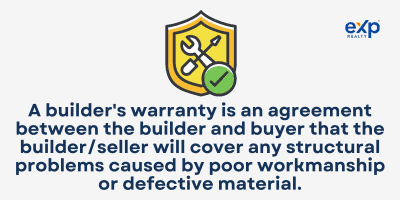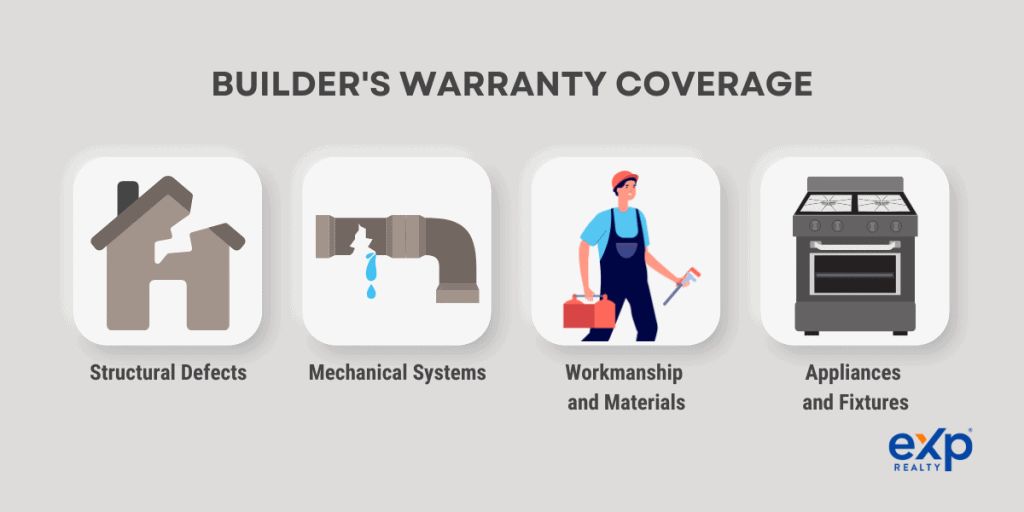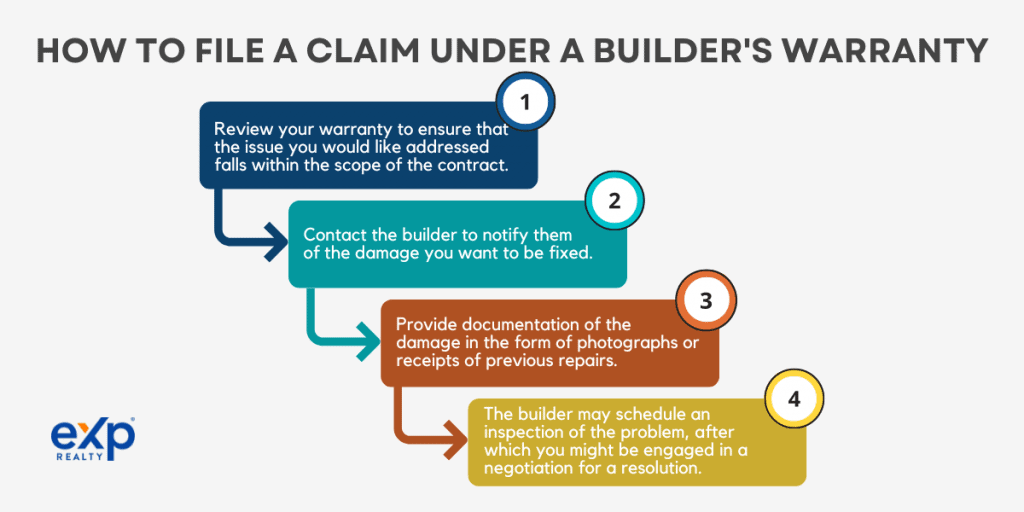In this day and age, it’s safe to assume that we’ve all bought something online. You might have researched and made sure you paid more for higher quality, but only some purchases go according to plan. The same can be said for new homes. Unlike that gift you bought on online marketplaces, a house costs more than a few thousand dollars. Luckily, you have the builder’s warranty as your “return” option.
There are many types of warranties for new homes, and the builder’s warranty is just the icing on the cake. Understanding warranties might mean the difference between enjoying your new home or living in constant fear that the roof might come crashing down (literally).
In the world of service contracts, builder’s warranties, and even home warranties, how do you stay afloat while keeping an eye on your new house and all its new requirements?
Well, you don’t have to. We’ve taken the time to provide an in-depth guide on builder’s warranties, warranty obligations, and how to lay your warranty claim when the need arises. Read on to find out how you can use that return button when the time comes.
What Is a Builder’s Warranty?

A warranty refers to the promise of a manufacturer to cover defects caused by poor workmanship or defective material. In line with this, a builder’s warranty, often referred to as a new home warranty, refers to an agreement between the builder of a new home (or the seller) and a buyer that the seller will cover any structural problems the buyer might encounter caused by defects in workmanship or defects in the quality of the material used for construction.
The builder (seller) might choose to provide coverage themselves (direct warranty) or enlist the services of a third party warranty company (purchased warranty) that sells warranties.
In addition to builder’s warranties, new homeowners can purchase a home warranty. In this case, the buyer adds a warranty to a house that might not necessarily be new. There is also a difference in the structures that might be covered by either one of these contracts.
The builder warranty coverage ranges from one-year warranty to 10-year structural warranty, depending on the type of contract and the seller. With most sellers, coverage on structural defects might last five to ten years, while repair on major home systems typically lasts between one and two years. You might be charged an additional $250-$350 annual service fee with your warranty.
Home Warranties
With a home warranty, you, as the buyer, decide whether or not you would be interested in purchasing the contract with your new home at an extra cost. Typically, a home warranty will cover common systems in the house, such as air conditioning systems or some common appliances, like laundry appliances.
However, this warranty often presents a stumbling block when trying to renovate or maintain. It may also be uneconomical when the number of repairs needed in the house is limited. It would help if you considered getting a home warranty when you are unsure about the structural integrity of your new home.
What Does a Builder’s Warranty Cover?

The best literature to reference the builder’s warranty would be in the documents given to you before or during closing. However, if this is not an option, you can use the following critical areas to get a natural feel:
Structural Defects
Getting your seller to fulfill their warranty obligations might be challenging, but with structural defects, you can rest assured that the problem will be addressed quickly. Major structural issues on the load-bearing beams, foundational defects (such as cracks or collapsing), roof problems, and even roof framing systems problems often lie within the scope of the warranty claim.
The builder’s warranty almost always covers the major home systems for five to ten years.
Mechanical Systems
From your house’s heating, ventilation, and air conditioning system to the plumbing and electrical systems. The mechanical systems of these systems remain in safe hands for one to two years. However, it is crucial to note that structural damage to these systems incurred through negligence on the buyer’s side might lead to the voiding of the house warranty.
Workmanship and Materials
Defects in workmanship and materials manifest as a crack in the foundation caused by the substandard pouring of materials, leaks in the roof due to substandard installation or low-quality materials, water damage from faulty plumbing installation, or even a warped/ buckled floor from poor quality fitting. For all these problems, coverage on workmanship applies.
Regardless of the reason, you need not torture yourself by turning a blind eye since all this may be covered in your coverage for workmanship.
Appliances and Fixtures
In some builder’s warranty contracts, you may kickstart the damage claim when eligible major appliances and fixtures are damaged or faulty while the contract is active. Examples of appliances that might be covered in the warranty include sinks, ovens, and water heaters. However, it would help to know if you referred to your warranty contract.
What Is Not Covered by a Builder’s Warranty?
You know what is covered by the builder’s warranty, but what might be outside the parameters of the builder’s warranty? It is essential to understand what is not covered by a builder’s promise to avoid being caught flat-footed when an expensive repair needs to be done. As mentioned earlier, different builders provide different warranties. Therefore, you should review your warranty’s exclusions and limitations sections to make an accurate assessment.
Some features that are typically not covered in a builder’s warranty include:
- Normal wear and tear
- Improper maintenance
- Acts of nature
- Third-party issues
Normal Wear and Tear
As time passes, the paint job on your house might lose its initial luster. You might also notice that the carpet looks better than when you moved in. However, before laying a claim on the builder’s warranty, you should note that most do not cover normal wear and tear, as this is expected with continued use.
Improper Maintenance
Before starting that DIY plumbing repair, you should always refer to what your warranty says. Structural damage resulting from improper maintenance by the buyer may not be covered in your warranty. Additionally, changes to your home that were not initially hidden in the scope of the warranty, such as adding a detached garage, might also not be covered.
Acts of Nature
You can’t always predict where the next hurricane will strike, nor can you expect where the next earthquake will hit. Consequently, builders rarely cover physical damage caused by natural disasters. However, you can offset these risks with a separate insurance policy if this will help you sleep better at night (at an extra cost).
Third-Party Issues
When you choose to involve a third party in the repairs or maintenance of your home and their actions result in physical damage to covered systems, you might not be eligible to claim the builder’s warranty. Additionally, for damage incurred through the efforts of an unrelated individual, such as in the case of theft, the builder may be exempted from covering the repairs.
How To File a Claim Under a Builder’s Warranty

To file a claim with your builder, you first need to review your warranty to ensure that the issue you would like addressed falls within the scope of the contract. This will save you time and resources in the long run and provide pointers on presenting your case to the builder.
Next, you should contact the builder to notify them of the damage you want to be fixed. You might inform them by phone, but it is better to do it in writing to ensure you have evidence of your correspondence with the builder. To avoid altercations or warranty voiding, notify the builder within the stipulated time frame.
The builder may seek documentation of the nature of the damage in the form of photographs or receipts of previous repairs. A handwritten description of the problem as well as filling out a form may also be required. Providing these documents promptly could mean the difference between having the repairs done or need to be considered.
At this stage, the builder may schedule an inspection of the problem, after which you might be engaged in a negotiation for a resolution.
How To Maintain Your Builder’s Warranty
Maintaining builder warranties throughout the validity time period is not a walk in the park. You must take a proactive approach and ensure you carry out routine maintenance (while documenting all the maintenance activities) to keep the house in near-perfect condition.
Additionally, you should ensure you understand the terms of your warranty and address issues promptly to ensure you have your best foot forward should a problem arise.
Key Takeaways
Builder warranties provide new homebuyers with the peace of mind of knowing they have financial protection from defects that might arise from poor workmanship or poor-quality materials during construction.
Understanding the terms of your warranty, what is covered, what is not covered, and even how to lay a claim on an issue realized is inevitably part of the home-buying process that you should ensure you are well conversant with. If you find this difficult, contact a professional for assistance. Ask a local real estate agent for help if you want to know more about new home warranties.
FAQs: New Home Warranties
Still unclear about new home warranties? Let’s look at some frequently asked questions.
Is a home warranty on a new home worth it?
The relevance of a home warranty depends on a variety of factors, with the most important being the owner’s individual needs and preferences. However, most new homebuyers agree that the peace of mind offered by a home warranty is worth the extra cost.
Can you sell a new house without a home warranty?
In most cases, it is possible to sell a new build house without a home warranty, but most buyers prefer the presence of one.
Do home warranties cover anything?
Home warranties cover several vital home systems, household appliances, and structural elements defects. However, it would be best if you looked through the exclusions and limitations of your warranty to understand what is not covered.
What are the subtypes of home warranties?
Although there are multiple kinds of warranty subtypes, the two most frequently encountered ones are extended warranties and special warranty deeds.
Extended warranty: Manufacturers offer extended warranties on high-value products like cars, electronics, and appliances, even though they are sold by the retailer. The manufacturer is in charge of carrying out the extended warranty on behalf of the customer.
Special warranty deed: A special warranty deed is a legal document that transfers property from one person to another. It guarantees that the buyer will receive the property without any liens, claims, or other issues. The deed provides an explicit warranty about the property title and gives ownership to the person receiving the property.





